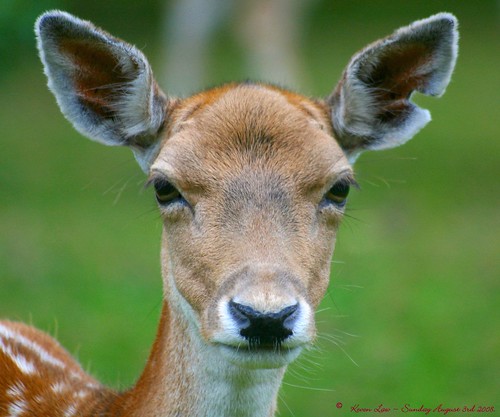Highest Explore position #482 ~ August 5th 2008.
Fallow Deer - Wildwood, Kent, England - Sunday August 3rd 2008.
Click here to see the Larger image
This is dedicated to my dear friend Kesha ~ Who's awesome images can be found here ~ www.flickr.com/photos/gottcha78/ ~ Thanks for the wonderful testimonial you left for me yesterday, it really meant a lot to me, I too hope to one day share a cup of tea with you...:O)))
Keep up the awesome work my friend...and I hope you find what your looking for...:O)))
From Wikipedia, the free encyclopedia ~ The Fallow Deer (Dama dama) is a ruminant mammal belonging to the family Cervidae.
The male is a buck, the female is a doe, and the young a fawn. Bucks are 140-160 cm long and 90-100 cm shoulder height, and 60-85 kg in weight; does are 130-150 cm long and 75-85 cm shoulder height, and 30-50 kg in weight. Fawns are born in spring at about 30 cm and weigh around 4.5 kg. The life span is around 12 years.
The species is very variable in colour, with four main variants, "common", "menil", "melanistic" and "albinistic". The common form has a brown coat with white mottles that are most pronounced in summer with a much darker coat in the winter. The albinistic is the lightest coloured, almost white; common and menil are darker, and melanistic is very dark, even black (easily confused with the Sika Deer). Most herds consist of the common form but have menil form and melanistic form animals amongst them (the three groups do not stay separate and interbreed readily).
Only bucks have antlers, these are broad and shovel-shaped. They are grazing animals; their preferred habitat is mixed woodland and open grassland. During the rut bucks will spread out and females move between them, at this time of year fallow deer are relatively ungrouped compared to the rest of the year when they try to stay together in groups of up to 150.
The Fallow Deer was a native of most of Europe during the last Interglacial. In the Holocene, the distribution was restricted to the Middle East and possibly also parts of the Mediterranean region, while further southeast in western Asia was the home of a close relative, the Persian Fallow Deer (Dama mesopotamica), that is bigger and has larger antlers. In the Levant, Fallow Deer were an important source of meat in the Palaeolithic Kebaran-culture (17000-10000 BC), as is shown by animal bones from sites in northern Israel, but the numbers decreased in the following epi-Palaeolithic Natufian culture (10000-8500 BC), perhaps because of increased aridity and the decrease of wooded areas.
The Fallow Deer was spread across central Europe by the Romans. Until recently it was thought that the Normans introduced them to Great Britain and to Ireland for hunting in the royal forests. However recent finds at Fishbourne Roman Palace show that Fallow Deer were introduced into southern England in the first century AD. It is not known whether these escaped to form a feral colony, or whether they died out and were reintroduced by the Normans.
The Fallow Deer is easily tamed and is often kept semi-domesticated in parks today. In more recent times, Fallow Deer have also been introduced in parts of the United States. In some areas of Central Georgia, wild fallow deer, not having any natural enemies, have increased to numbers that cause serious damage to young trees. Fallow Deer have also been introduced in Texas, along with many other exotic deer species, where they are often hunted on large game ranches.
One noted historical herd of fallow deer is located in the Ottenby Preserve in Öland, Sweden where Karl X Gustav erected a drystone wall some four kilometres long to enclose a royal fallow deer herd in the mid 1600s; the herd still exists as of 2006.
For a Dear Friend.......
Subscribe to:
Post Comments (Atom)

0 comments:
Post a Comment
Please use only family-friendly words. Otherwise, your comment will be filtered out. :D
You can use some HTML tags, such as b, i, a